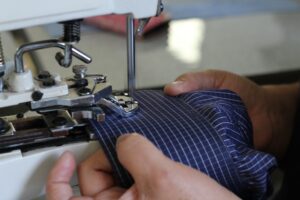In response to reports of endemic forced labor, child labor, and hazardous working conditions in India’s textile industry, Transparentem began in 2016 to investigate spinning mills and garment factories in Tamil Nadu that supply products to the global market. Transparentem’s investigation focused on workers’ experiences producing garments, fabric, or yarn for four manufacturing groups. At each group, Transparentem collected evidence of multiple forced labor indicators as described by the International Labour Organization (ILO).
Transparentem’s subsequent engagement with companies sourcing from these suppliers resulted in improvements to factories’ labor practices at three of four investigated manufacturing groups. Notably, buyers reported that manufacturers strengthened age-verification systems, reassigned some young workers to lighter duties, improved dormitory conditions and management, established training for managers on avoiding gender-based harassment, and eliminated a double-bookkeeping system.
This project alerted companies to abuses at spinning mills and benefited workers who often fall outside the scope of companies’ social compliance programs, which frequently only cover final-assembly “first tier” production facilities. Several companies also reported strengthening policies around oversight of facilities beyond the first tier due to this project. They also increased worker involvement in audit processes and strengthened company codes of conduct.
Transparentem identified several areas for continued improvement. For example, companies should continue to exercise due diligence and alleviate any exploitation of young workers or restrictions on workers’ movement. They should also support living wages and freedom of association in Tamil Nadu. We outline other recommendations below.
Investigative Findings
Investigators interviewed upwards of 120 workers and more than 20 of their family members; spoke with recruiters, trainers, and company managers; and reviewed extensive documentation of manufacturer procedures and workers’ ages. Investigators found that many interviewees were hired when under 18, from marginalized castes and impoverished families. Many lived far from home and could not speak Tamil, Tamil Nadu’s main language.
Investigators found evidence pointing to abuse of these workers’ vulnerability, along with other forced labor indicators: excessive overtime, abusive working and living conditions, restriction of movement, retention of identity documents, intimidation and threats, sexual violence, and isolation. Transparentem found some of these indicators at each of the four manufacturers, as summarized below. This list is not exhaustive of the investigation’s findings, and investigators did not find every indicator at each manufacturing group.
Young workers and audit deception: Investigators determined that a majority of interviewees were hired between the ages of 14 and 17. Transparentem learned that most of these laborers worked long hours and night shifts as if they were adults. At two manufacturing groups, workers told investigators they had been hired before they turned 14. Workers said staff at production facilities across the four manufacturing groups concealed young workers from compliance auditors by hiding them or coaching them to lie about their ages.
One young worker told investigators, “If [auditors] come, they don’t let us outside . . . They lock us in a room. They let us out only after they leave.”
Restricted movement: Transparentem found that factory staff at three manufacturing groups restricted workers’ movement, and gathered some evidence of restricted movement at the fourth group. Some migrant workers at two manufacturers said they could not access their identity documents because representatives from their workplace training centers held them hundreds of miles away in their home state.
“Even if we want to go to the bathroom, we must get permission,” one worker told investigators. Others said they had been locked inside their workplace, not allowed to leave their hostel at will, or restricted from taking leave or quitting.
Abusive working conditions: Interviewees across all four manufacturing groups experienced hazardous working conditions, including: cotton dust inhalation, prolonged exposure to excessive heat, injuries from machines, and the toll of long hours and night work on the physical and mental development of adolescents.
One former worker told investigators that when she complained about pain in her leg, a supervisor told her to “shut up and work.”
At another manufacturer, workers described unwanted sexual advances from supervisors, restricted communication with people outside the factory, and poor living conditions.
Buyer and Manufacturer Responses
Beginning in December 2019, Transparentem contacted 31 companies identified as customers of the four manufacturing groups, sharing reports of the labor issues found, along with recommended remedial actions, policy enhancements, and advocacy priorities that companies should pursue in response.
Of these companies, 20 agreed to collaborate with each other or work alone to follow up with three of the manufacturing groups. These companies assessed conditions themselves or contracted third-party ethical-sourcing consultants, focusing on the experiences of then-current workers. Nineteen companies developed corrective action plans to address labor issues their assessments identified.
In each of the respective manufacturing groups where companies undertook remedial action, companies broadly confirmed detecting issues within most or all of the categories of forced labor indicators that Transparentem found. However, they did not confirm all of Transparentem’s specific findings. For example, companies said they found no workers under 14, nor excessive hours for workers under 18. Yet corrective action plans at one facility included reassignment of some workers under 18 to lighter duties without overtime, and all manufacturers’ corrective action plans included strengthening age-verification procedures.
All three manufacturers committed to management and worker training on age verification, hours-of-work restrictions, and other compliance issues, including freedom of movement, grievance reporting, gender-based violence and harassment, and health and safety procedures.
One manufacturer called its response to buyers asking for improvements based on Transparentem’s investigation an “opportunity to bring about total transformation” of its human resources procedures.
Companies’ other corrective actions included: dormitory improvements at two manufacturers, better provision of personal protective equipment (PPE) to workers at one manufacturer, and elimination of a double-bookkeeping system found at one manufacturer that had made it impossible for third parties to assess workers’ overtime hours.
Beyond direct actions with manufacturers, several companies also reported improving internal corporate policies to prevent the recurrence of issues Transparentem identified across their supply chains. Some companies described changes to their audit policies to better involve workers and increase unannounced factory visits. Others described updating their codes of conduct to strengthen prohibitions on forced labor and ensure that factories maintain adequate dormitory facilities for workers. Eight companies told Transparentem they were increasing oversight of working conditions beyond the first tier of their supply chains. And 10 companies supported two industry-level campaigns to increase Tamil Nadu’s minimum wage to better align it with ILO standards.
Conclusion
To build upon this project’s positive outcomes, Transparentem has identified further necessary actions. Companies should:
- Support worker representation and leadership by conveying their strong support for freedom of association to their suppliers. They should insist that suppliers communicate the same to workers.
- Combat audit deception and strengthen due diligence by implementing audit protocols, including worker-participation mechanisms that accurately document their ages and experiences.
- Deter exploitation of young workers, clearly communicating that suppliers must adhere strictly to legal limits for young workers, and exercising strong due diligence.
- Provide redress for past harm whenever they identify adolescents or children who work or have worked in prohibited conditions, providing adequate compensation, protection, and remedial education.
- Protect workers’ freedom of movement, ensuring that factory management does not limit workers’ movements to certain hours or impose chaperone requirements.
- Advocate for worker protections and a living wage to reduce workers’ vulnerability to exploitation.
- Improve oversight beyond the first tier of production by tracing supply chains and working with suppliers to extend strong labor protections to workers at the spinning mill level and beyond.
Buyers and suppliers must establish and implement policies across their supply chains that can mitigate labor abuses including restriction of movement, child labor, exploitation of young workers, and other issues found by this investigation.
For more information about this project, please contact info@transparentem.org.





